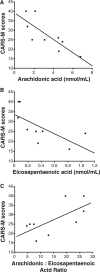Plasma free polyunsaturated fatty acid levels are associated with symptom severity in acute mania
- PMID: 17988367
- PMCID: PMC2238693
- DOI: 10.1111/j.1399-5618.2007.00387.x
Plasma free polyunsaturated fatty acid levels are associated with symptom severity in acute mania
Abstract
Objectives: Nutritionally essential polyunsaturated fatty acids (PUFAs) have been implicated as potentially important factors in mood disorders. For instance, n-3 PUFA supplementation is reported to improve outcomes in major depressive disorder and bipolar disorder. However, the role of PUFAs in acute mania has been minimally investigated. We performed a pilot study to compare plasma levels of free (non-esterified) and esterified PUFAs between patients in an acute manic episode and healthy volunteers, and to explore associations between symptom severity and levels of fatty acids and of the arachidonic acid metabolite, prostaglandin E2 (PGE2).
Methods: Patients (n=10) who were medication-free for at least two weeks and seeking inpatient admission for an acute manic episode were compared with healthy volunteers (n=10). Symptom severity was assessed at admission and after six weeks of naturalistic treatment. Fasting baseline free and esterified plasma levels of docosahexaneoic acid (DHA, 22:6n-3), eicosapentaenoic acid (EPA, 20:5n-3), arachidonic acid (AA,20:4n-6) and the AA metabolite PGE2 were determined, and PGE2 levels were tested again at six weeks.
Results: No between-group differences were found in levels of individual or total fatty acids, or of PGE2. Among subjects, manic symptom severity correlated negatively with levels of free AA and free EPA, and positively with the free AA:EPA ratio. PGE2 levels did not differ between groups or in subjects pre- and post-treatment.
Conclusions: Our preliminary results suggest that, in susceptible persons, low plasma levels of free EPA compared with AA are related to the severity of mania.
Figures

Similar articles
-
Low unesterified:esterified eicosapentaenoic acid (EPA) plasma concentration ratio is associated with bipolar disorder episodes, and omega-3 plasma concentrations are altered by treatment.Bipolar Disord. 2015 Nov;17(7):729-42. doi: 10.1111/bdi.12337. Epub 2015 Oct 1. Bipolar Disord. 2015. PMID: 26424416 Free PMC article.
-
Meta-analysis of erythrocyte polyunsaturated fatty acid biostatus in bipolar disorder.Bipolar Disord. 2016 May;18(3):300-6. doi: 10.1111/bdi.12386. Epub 2016 Apr 18. Bipolar Disord. 2016. PMID: 27087497 Free PMC article.
-
Selective deficits in erythrocyte docosahexaenoic acid composition in adult patients with bipolar disorder and major depressive disorder.J Affect Disord. 2010 Oct;126(1-2):303-11. doi: 10.1016/j.jad.2010.03.015. Epub 2010 Apr 21. J Affect Disord. 2010. PMID: 20413162 Free PMC article.
-
A meta-analytic review of polyunsaturated fatty acid compositions in dementia.J Clin Psychiatry. 2012 Sep;73(9):1245-54. doi: 10.4088/JCP.11r07546. Epub 2012 Aug 7. J Clin Psychiatry. 2012. PMID: 22938939 Review.
-
Polyunsaturated fatty acids in the central nervous system: evolution of concepts and nutritional implications throughout life.Reprod Nutr Dev. 2004 Nov-Dec;44(6):509-38. doi: 10.1051/rnd:2004063. Reprod Nutr Dev. 2004. PMID: 15762297 Review.
Cited by
-
Dietary omega-6 fatty acid lowering increases bioavailability of omega-3 polyunsaturated fatty acids in human plasma lipid pools.Prostaglandins Leukot Essent Fatty Acids. 2014 May;90(5):151-7. doi: 10.1016/j.plefa.2014.02.003. Epub 2014 Feb 24. Prostaglandins Leukot Essent Fatty Acids. 2014. PMID: 24675168 Free PMC article. Clinical Trial.
-
Omega-3 polyunsaturated fatty acid (PUFA) status in major depressive disorder with comorbid anxiety disorders.J Clin Psychiatry. 2013 Jul;74(7):732-8. doi: 10.4088/JCP.12m07970. J Clin Psychiatry. 2013. PMID: 23945451 Free PMC article.
-
Validation of a food frequency questionnaire to assess intake of n-3 polyunsaturated fatty acids in subjects with and without major depressive disorder.J Am Diet Assoc. 2011 Jan;111(1):117-123.e1-2. doi: 10.1016/j.jada.2010.10.007. J Am Diet Assoc. 2011. PMID: 21185973 Free PMC article.
-
Pathways of polyunsaturated fatty acid utilization: implications for brain function in neuropsychiatric health and disease.Brain Res. 2015 Feb 9;1597:220-46. doi: 10.1016/j.brainres.2014.11.059. Epub 2014 Dec 8. Brain Res. 2015. PMID: 25498862 Free PMC article. Review.
-
Bipolar disorder moderates associations between linoleic acid and markers of inflammation.J Psychiatr Res. 2017 Feb;85:29-36. doi: 10.1016/j.jpsychires.2016.10.021. Epub 2016 Oct 27. J Psychiatr Res. 2017. PMID: 27821270 Free PMC article.
References
-
- Piomelli D. Arachidonic Acid in Cell Signaling. RG Landes; Austin, TX: 1996. pp. 55–78. - PubMed
-
- Assies J, Lieverse R, Vreken P, Wanders R, Dingemans P, Linszen D. Significantly reduced docosahexaenoic and docosapentaenoic acid concentrations in erythrocyte membranes from schizophrenic patients compared with a carefully matched control group. Biol Psychiatry. 2001;49:510–522. - PubMed
-
- Kinsella J. Lipids, membrane, receptors, and enzymes: effects of dietary fatty acids. J Parenter Enteral Nutr. 1990;14:200–217. - PubMed
-
- Calderon F, Kim HY. Docosahexaenoic acid promotes neurite growth in hippocampal neurons. J Neurochem. 2004;90:979–988. - PubMed
-
- Kim HY, Akbar M, Lau A, Edsall L. Inhibition of neuronal apoptosis by docosahexaenoic acid (22:6n-3). Role of phosphatidylserine in antiapoptotic effect. J Biol Chem. 2000;275:35215–35223. - PubMed
Publication types
MeSH terms
Substances
Grants and funding
LinkOut - more resources
Full Text Sources
Medical
Research Materials

